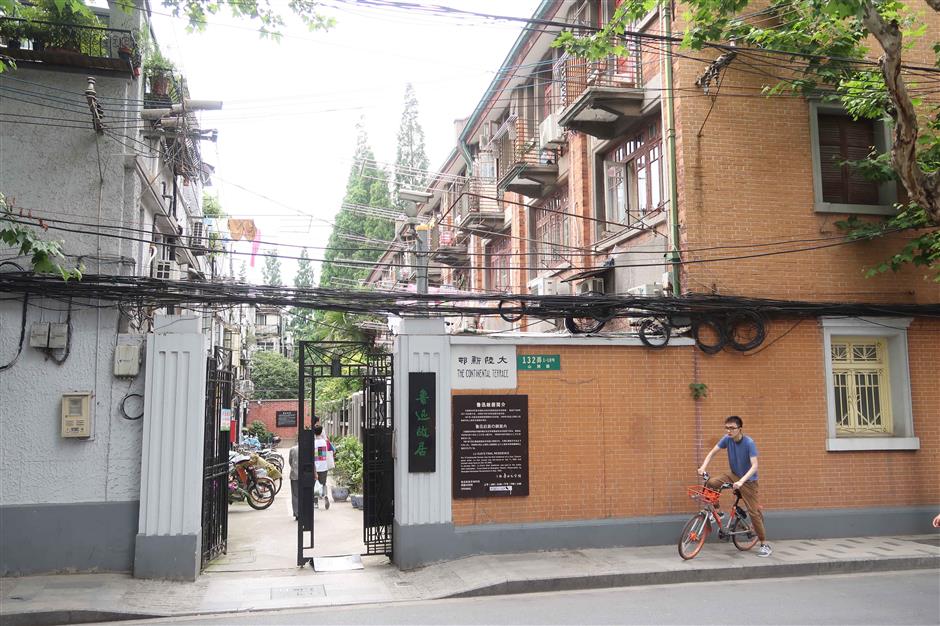Lined with plane trees, a street steeped in history
Shanyin Road in the northeastern corner of Hongkou District is like an open-air museum, with its variety of building styles from the 1930s and 1940s and its rich history of famous residents.
The 651-meter-long street was at one time home to literati and revolutionaries, including authors Lu Xun (1881-1936) and Mao Dun (1896-1931). It also housed Qu Qiubai (1899-1935), a leader of the Communist Party of China in the late 1920s, and Zeng Liansong (1917-99), designer of the Party flag.
Its deep historical significance doesn’t mean the community today is serious or dull. The roadside is lined with leafy plane trees that were planted in the 1970s and give the street a certain romantic charm.

The 651-meter-long Shanyin Road is lined with leafy plane trees.
Still, the cultural past of Shanyin Road does give it a more solemn atmosphere than other lane-house neighborhoods. There are few chairs that bring the life of residents out into the alleyway. Xia Shan, Party secretary of Shanyin Road No. 3 Neighborhood Committee, says local residents have always preferred tranquility.
“Instead of playing games in the lane, my classmates in the neighborhood and I just went home after class and did our homework,” recalls Li Luogen, 83. “The lane was always very quiet.”
For outdoor recreation, the local residents went to nearby Lu Xun Park, he says. The park, about a five-minute walk from Shanyin Road, contains the tomb of Lu, with an inscription by Chairman Mao Zedong.
Musicians, painters, teachers and researchers once lived in the area, giving it an educated, artistic tone.
“Residents here always attach great heed to education, which gives the community its unique atmosphere,” says Chen Rongqing, Party secretary of Shanyin Road No. 1 Neighborhood Committee. “They are honest, humble and down-to-earth.”

A man trims climbing vines in Dongzhao Lane, where Qu Qiubai, formerly a leader of the Communist Party of China, lived.

A kitten rests on the wall of Qu Qiubai's former residence at Building 12 of 133 Shanyin Road.

Shikumen, or stone-gated houses, and garden villas dominate here. Wenhua Villa, built in 1932 at 208 Shanyin Road, features a British terrace-house style, while Dongzhao Lane, where the revolutionary Qu lived, combines the style of lane houses with Japanese architectural elements.
Many of the buildings on Shanyin Road were constructed by banks and inhabited by their employees.
“My husband’s grandfather worked at a foreign bank, which allocated a unit to him,” says an elderly woman living at 112 Shanyin Road. “Staff at the assistant manager level had a choice of flats on the first, second or third floor, while a bank manager was entitled to a whole house.”
She says the neighborhood was once called Liu Qing Xiao Zhu, a poetic name now familiar only to the older residents.
The symmetrical layout of the neighborhood is unique. The gates of the two rows of houses face each other. Built in 1937, the site was designated as a cultural heritage spot.

Xing Ye Fang was built by the former Zhejiang Xingye Bank in 1927.

Dalu New Village, or Continental Terrace, was owned by Dalu Bank.
Former Zhejiang Xingye Bank built the Xing Ye Fang property in 1927, while Dalu Bank owned Dalu New Village, or Continental Terrace, built in 1931.
One of the famous landmarks of the area was the Uchiyama Bookstore, a popular hangout with left-wing intellectuals. Its owner, Kanzo Uchiyama (1885-1959) from Japan, was a friend of Lu and other writers of the day. The shop specialized in left-wing books and held regular sessions on literature and art.
By 1932, Uchiyama had become the sole publisher of Lu’s works. In the last decade of his life, Lu purchased more than 1,000 books there, and the two men remained close friends until Lu’s death.
In the building that houses a bank, there is a Japanese doll sent by Uchiyama to Lu’s son, Zhou Haiying. A bill showing books that the Chinese author bought in the shop sits alongside a modern ATM.
Along Shanyin Road are two small restaurants famed for steamed and fried buns, a shop selling bamboo mats, a shoe repair stall, a vintage furniture store, a fruit stand in the front garden of a villa and several clothing stores for middle-aged women. Another older shop selling silk dresses and crowded with customers is due to close soon.
“This shop has been operating for more than 30 years,” says its owner. “Though business remains good, we want to enjoy retirement and decided to close the store.”

Hengfeng Lane is also called Huaxiang Lilong, or "floral fragrance lane."

Though the street has kept its original appearance and the layout of the neighborhoods basically remains, the residents and the environment have changed.
“Around 400 of our 1,158 households are not incomers,” says Party Secretary Chen. “Many houses have been rented to migrant workers. The natural environment has greatly improved in Hengfeng Lane, which is also called Huaxiang Lilong, or ‘floral fragrance lane.’
“The area smells of the fragrance of chimonanthus in winter, osmanthus in the autumn and gardenia in the spring,” he says.
In Xing Ye Fang, also known as Shuxiang Lilong, or “book fragrance lane,” hang painting reproductions of works done by older residents of the area.
“The lane is livelier than ever before,” says Jiang Meisheng, 80, showing me pictures of local activities on her iPad. “We elderly women set up an organization that holds an activity every week. For example, we cooked Laba congee on the Laba Festival, and several hundred people came to eat.”
“Tranquility has always been a characteristic of the neighborhood, but now the neighborhood wants to enliven itself a bit,” says Party Secretary Xia. “We want our elderly residents to feel warm rather than lonely.”

Painting reproductons of works done by older residents can be found in Xing Ye Fang, also known as Shuxiang Lilong, or "book fragrance lane."
















